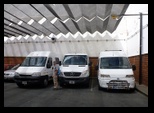



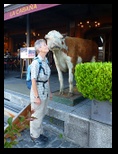

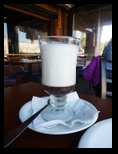
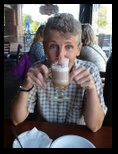
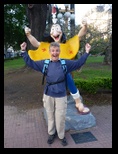

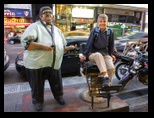

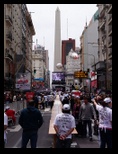
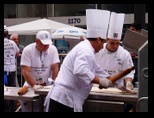
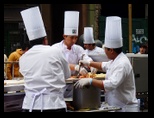
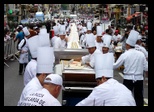
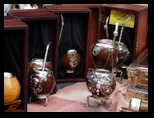
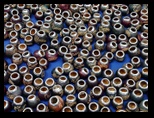
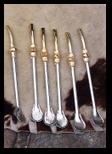
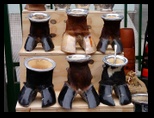
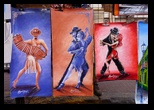
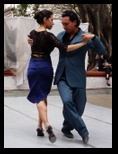
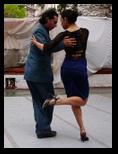
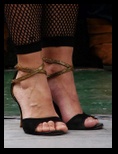
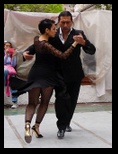
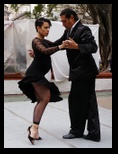
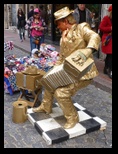
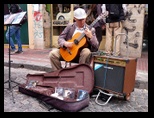
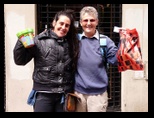
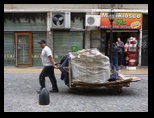
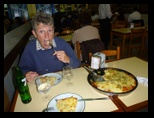
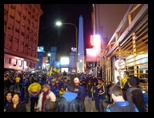

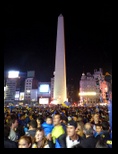

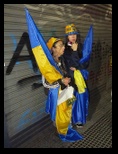
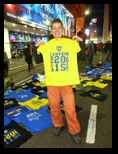

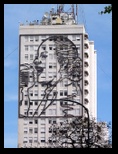
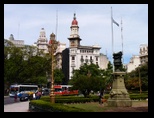
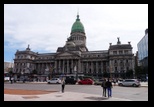
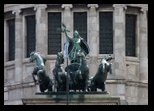


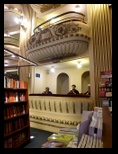
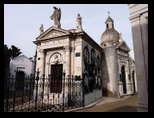
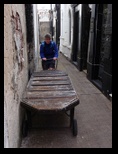
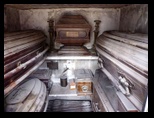
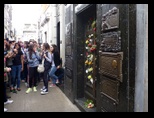
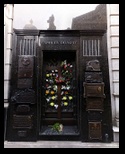

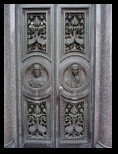

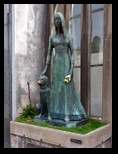
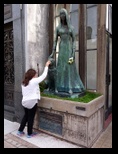
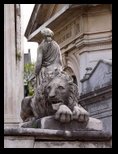
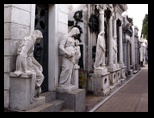
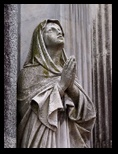
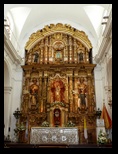
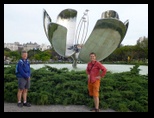

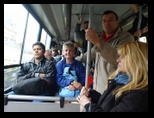
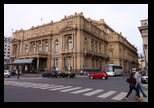
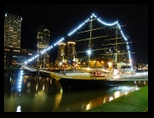


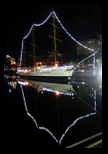
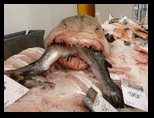
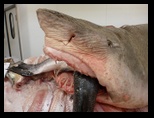
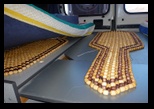
Argentina has a total population of over 40 million people and approx 30% of them live in Buenos Aires. The last time we were here was in 2002 on a camping tour through South America. So back then we didn't have to drive. That changed this time around though and it didn't take long for us to remember why we don't like big cities!
We had heard from other travellers that there was a secure parking area right next to the ferry station but when we checked it out, it was just an open parking lot with a security man in a little hut and cost 350 pesos for the night (approx $24). It was only $10 a few weeks ago so the prices had taken a real hike for the high season!
It was on a large main street, very noisy, with no restaurants or businesses nearby and quite a way from the attractions. We weren't too sure about Winnietwo's safety on such an open area. We planned about a week in the city and would be leaving Winnietwo on his own most days whilst we went sightseeing so we decided to check out other possibilities nearer to the city centre.
This meant driving through rush hour traffic as it was already 8am. We were both tired because we hadn't had much sleep and had been up since 2-50 am for the ferry crossing so it wasn't easy driving in such a huge city with all the traffic. Even with GPS it wasn't always obvious which road we had to take. I'm sure we drove down one street that was bus and taxi only - the signs were very confusing!
There didn't seem to be any lane markings and there was hardly any space between the mirrors of parked cars on my right and the mirrors of the vehicles whizzing past me on my left. Bus and taxi drivers think they have right of way at all times and I really had to concentrate. Yikes!
Our GPS wanted us to turn left onto the largest street in the world - 10 lane wide Avenida 9 de Julio. I was in position with my indicator on and watching for an opportunity to get across. But a police woman started frantically waving her arms at us and telling us to drive straight on. Obviously we weren't allowed to turn left! So I had no choice. We drove straight on and then did three right turns in quick succession to get where we needed to be. Even our GPS makes mistakes!
We drove to three other parking areas - I pulled over whilst Kirsten jumped out to check them. The third was the one we chose - very close to the Obelisk in the city centre, 24 hours for 290 pesos (approx $18), surrounded by high buildings with a large gate at the front, covered with netting overhead and right next to a Carrefour supermarket. It also had a bathroom with a toilet and sink so we could get water and empty our porta potti which only lasts 3 days. A perfect spot with several subway stations for the various lines around the corner and surprisingly quiet. We stayed for 7 nights.
We parked up just before 9am and tried to get some sleep. At least Kirsten managed but I was still too wired from driving us here safely and couldn't switch off. What was switched off was our fridge! We needed a new back battery as the current one had died on us last night in Colonia and we had to use torches. Although we had solar power, we had been on the ferry and then only driven a short way to our parking spot which was covered. So we wouldn't be generating any power whilst parked there.
Having a supermarket next door helped and we could buy what we needed up to 10pm at night. But first we needed pesos.
Back in 2002 the Argentinian peso was linked to the US dollar and was 1 to 1. But the country was in such dire straits it was on the brink of collapse. In December 2001 the president resigned and the country went through three more presidents within 2 weeks until President Dehalde was put in power. He devalued the peso, defaulted on $140 billion of debt and the peso went into freefall.
We were there in February 2002 when the peso was still 1 to 1. Within two weeks it dropped to half and was 2 to 1, four weeks later it was 4 to 1 and was only worth 25% of its value. For us it was good because we got 4 times more pesos for the dollar. For the country and its people it was a disaster. We witnessed the demonstrations and saw the vandalism directed at the banks.
Today the official rate is 9 Pesos to the dollar but there is also the unofficial rate called the Blue Dollar. If you have shiny new $100 bills you can get around 15 pesos to the dollar which is a huge difference to the official rate and the authorities turn a blind eye.
Avenida Florida is the main place to get Blue Dollar pesos where dozens of men and women shout "Cambio, Cambio" and take you off to an office somewhere to get your money. We haggled with various people who started off at 15 to the dollar and finally got an offer of 15.6. We were taken into a passage entrance, took a lift up to the second floor and our "Guy" knocked on an office door. We had to wait a few moments and then were taken into an office to talk to the "bank manager"! There was only a old wooden desk with a large man around 60.
We told him how much we wanted to change, a calculator was used and then a large amount of 100 peso notes were counted out and rechecked by us before we handed over our dollars. The 100 peso note is the largest there is - it used to be worth $100 but at the Blue Dollar rate it's only worth $6-40. We ended up with 78 notes for $500!
It turned into a sunny day so we bought a map and bus plan for the city, and walked to the Casa Rosada - the official presidential building where Evita Peron shouted to the masses from the balcony around 1950. (She died of cancer at the age of 35 in 1952.)
We crossed the busy roads and walked to Puerto Madero. The old docks have been renovated and there is a nice promenade and plenty of restaurants. We spent some of our pile of pesos at TGI Fridays on the waterfront and shared a chicken fajita - not exactly typical local food so I had a chocolatada which is a speciality of Buenos Aires to balance it up!
The next evening we finally met up with Janette who runs the Seabridge RV tours along the famous Panamericana route from BA, south to Ushuaia then north through South and Central America, Mexico and into the US.
Our first contact with her and Uwe was in 2004 when they were working out a route for tours they were planning in the future. She left a message in our guest book whilst doing the research and since then we have been in email and Skype contact. We came very close to meeting up in Guatemala and the US but it never happened.
Now we were in BA using McDonalds to try and get internet which was very slow and intermittent but we got a Skype message from Janette and she invited us to her apartment. We quickly packed up and hopped on the next subway and finally got to meet her in person!
We had so much to talk about that we barely scratched the surface. It got late and because the subways only run until 10-30pm we had to get a bus back. At least we are parked right next to the Obelisk in the city centre where most bus routes converge! The bus plan we had bought is complicated and confusing at first. It takes a couple of days before you can work with it!
On Sunday morning the largest pizza in Buenos Aires was being prepared in the street right in front of our parking area! We wanted to get to the Fería Mataderos - a Sunday market with folk music, tango dancing etc. It's quite a way out and the bus we needed left from Casa Rosada. We kept asking various people where the bus stop was and kept getting different answers! We tried all the ones that were suggested and dozens of buses came past but not ours!
After waiting over an hour we gave up and walked to the nearby San Telmo market which is the more touristy version but we really enjoyed it. Live music was being played on every corner as we walked down the long road full of stands. There were a number of classical guitar players and every single one was excellent and played like professionals.
Tango is the soul of Argentina so we watched several couples dancing. The history of the tango started at the end of the 19th Century when great waves of European settlers came to the Rio de la Plata region in Argentina and Uruguay. The mixture of Italian, Spanish, East European and Jewish newcomers mingled with the local population, itself a combination of Hispanics, blacks and indigenous Americans. Each of these groups had its own musical heritage.
In the rough-and-tumble world of the predominantly male immigrants and working poor, the pulsing rhythm known as the candombe that arrived with African slaves mixed with the haunting melodies of Andalusia and southern Italy and the locally popular milongas (traditional gaucho songs). Sometime during the 1880s, all these cultural elements fused to give rise to something completely new - the tango. Exactly when and where is both a mystery and a hotly disputed controversy.
Gradually the tango moved from the poorer areas into the salons of the rich and then it was taken up in Paris and its fame became international. In the late 1940s, tango became increasingly associated with Peronism and his kind of strident nationalism. In consequence, it suffered when Perón was toppled and went into exile, giving way to more international styles such as pop and rock. In the 1960s, the last thing young Argentines wanted to be seen doing was dancing the old-fashioned, stale tango.
It was revived later and now thousands of pesos can be earned on the streets, in cafés and in theatres and we could watch the dancers in San Telmo.
Tango in San Telmo.
Later we went for a pizza seeing as today was obviously pizza day with the largest in Buenos Aires being prepared. Lots of televisions in the restaurant were showing a live football match. What we didn't realise was that it was the last match of the local team, Boca Juniors, and when they won it, they also won the championship.
What we also didn't realise was that the Obelisk (67m high and built in 1936) where we are parked is also the spot where all the fans come to celebrate a big win. So the whole area was inundated with thousands of fans! They were all very happy and there were lots of families with small children and there was never a sense that we would be in danger. The atmosphere was unbelievable and they celebrated until well after midnight!
Boca Junior fans celebrating the championship at the Obelisk.
On Monday we spent the day shopping, firstly looking for a new battery in an area where all the vehicle parts shops are congregated and compared prices. Finding the right battery here is difficult and expensive. A lot of motor homes here have problems with batteries because there are a lot of gravel roads to drive on if you want to see the various marine and bird colonies along the coast. The amount of shaking, rattling and rolling takes its toll and batteries don't last.
We would have to just get a normal battery for the back to attach to the solar panel and run the compressor fridge, lights, pumps etc until we can get a better one in Chile next year.
Then we took a bus to Walmart and Easy (the Argentinian version of Home Depot) to buy various things we needed for Winnietwo - fleece blankets, mosquito netting and Velcro for the doors, a bucket for hand washing, Ikea style racks that are ideal to keep various things handy and two coffee mugs. It was after 9pm when we finished and the bus back took well over an hour. A very long day.
The rest of the week we did more sightseeing.
El Ateneo is second on the Guardian's list of the top ten bookshops in the world. (The number one is in Maastricht, Holland.) It is located in an old theatre built in 1919 with bookshelves where the main seating area once was and a café on the stage. Of course we had to have a cappuccino and a very nice slice of passion fruit cheesecake!
El Ateneo - the largest and most beautiful bookshop in Buenos Aires.
Cemeterio de la Recoleta: this cemetery is arguably BA's number-one attraction. Located in the upscale, northern barrio of the same name, the cemetery has been the burial place of choice for Argentina's elite since the mid-19th century. Presidents, military generals, artists, aristocracy, and, most famously, Eva Perón lie interred here in fabulous mausoleums of granite and bronze.
The Floralis Genérica is a sculpture by architect Eduardo Catalano consisting of large aluminium and steel petals that turn with the sun and open as the sun's intensity increases. As the sun fades the blooms close. It was installed in April 2002 so we missed it by a month the last time we were here.
Teatro Colón is the city's main performing-arts venue and the only facility of its kind in the country, a world-class forum for opera, ballet and classical music with astounding acoustics. Occupying an entire city block, the Colón can seat 2500 spectators and provide standing room for another 500.
On our last night in BA we returned to Puerto Madero to take evening shots of Puente de la Mujer. It resembles a sharp fishhook or even a harp - but is supposed to represent a couple dancing the tango. Designed by acclaimed Spanish architect Santiago Calatrava and mostly built in Spain, this 160m-long pedestrian bridge cost AR$6 million and rotates 90 degrees to allow water traffic to pass - when it's functioning, that is.
As we left BA, we went back to Avendida Warnes street to buy and install a new back battery and drove out to Walmart to buy some wooden lattice seat covers meant for car seats. We wanted to use them under the cushions for our table which turns into a bed. This would provide air circulation underneath to prevent humidity causing a problem. It was Black Friday and we took advantage of the killer prices along with photos of the shark on display! Next stop was a Jumbo supermarket in Pilar about 34 km further out of BA where we got great deals on the chocolate - 2 for the price of 1 on Black Friday!
Afterwards we drove to San Antonio de Areco where a Gaucho festival would be taking place over the weekend. We drove to the campground and met up with Glenda and Jamie from England who we had met in Paraiso Suizo and also talked to the Seabridge French group who had spent all day yesterday trying to get their campers off the ship and were a day late getting here.
Somehow we managed to get a better price for camping here - normally 320 pesos a night. We said we are only a small vehicle and asked if the price could come down to 300. The man went straight down to 250 pesos and we paid for 3 nights!